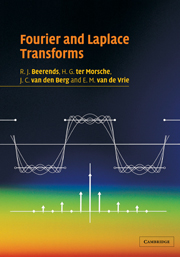Book contents
- Frontmatter
- Contents
- Preface
- Introduction
- Part 1 Applications and foundations
- Part 2 Fourier series
- Part 3 Fourier integrals and distributions
- 6 Fourier integrals: definition and properties
- 7 The fundamental theorem of the Fourier integral
- 8 Distributions
- 9 The Fourier transform of distributions
- 10 Applications of the Fourier integral
- Part 4 Laplace transforms
- Part 5 Discrete transforms
- Literature
- Tables of transforms and properties
- Index
9 - The Fourier transform of distributions
Published online by Cambridge University Press: 05 June 2012
- Frontmatter
- Contents
- Preface
- Introduction
- Part 1 Applications and foundations
- Part 2 Fourier series
- Part 3 Fourier integrals and distributions
- 6 Fourier integrals: definition and properties
- 7 The fundamental theorem of the Fourier integral
- 8 Distributions
- 9 The Fourier transform of distributions
- 10 Applications of the Fourier integral
- Part 4 Laplace transforms
- Part 5 Discrete transforms
- Literature
- Tables of transforms and properties
- Index
Summary
INTRODUCTION
In the previous chapter we have seen that distributions form an extension of the familiar functions. Moreover, in most cases it is not very hard to imagine a distribution intuitively as a limit of a sequence of functions. Especially when introducing new operations for distributions (such as differentiation), such an intuitive representation can be very useful. In section 8.1 we applied this method to make it plausible that the Fourier transform of the delta function is the constant function 1, and also that the reciprocity property holds in this case.
The purpose of the present chapter is to develop a rigorous Fourier theory for distributions. Of course, the theory has to be set up in such a way that for functions we recover our previous results; this is because distributions are an extension of functions. This is why we will derive the definition of the Fourier transform of a distribution from a property of the Fourier transform of functions in section 9.1. Subsequently, we will determine the spectrum of a number of standard distributions. Of course, the delta function will be treated first.
In section 9.2 we concentrate on the properties of the Fourier transform of distributions. The reciprocity property for distributions is proven. We also treat the correspondence between differentiation and multiplication. Finally, we show that the shift properties also remain valid for distributions.
It is quite problematic to give a rigorous definition of the convolution product or to state (let alone prove) a convolution theorem.
- Type
- Chapter
- Information
- Fourier and Laplace Transforms , pp. 208 - 228Publisher: Cambridge University PressPrint publication year: 2003

